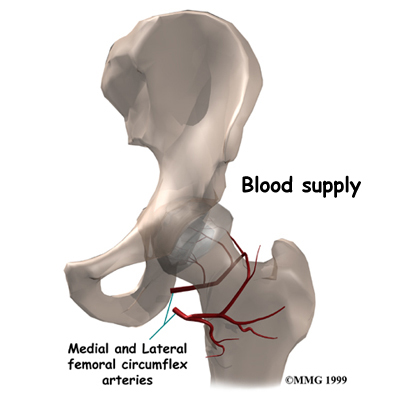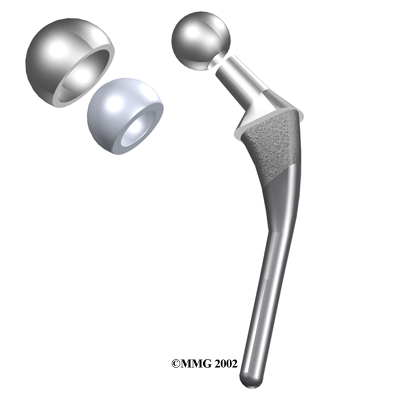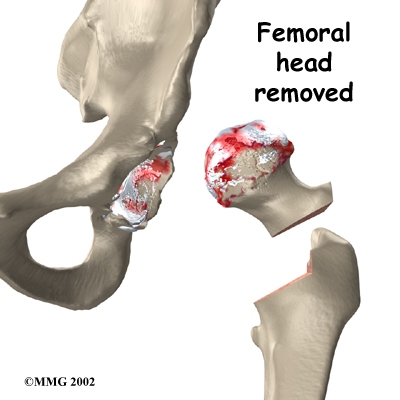|
|
Hemiarthroplasty of the Hip
IntroductionPhysiotherapy in Regina, Physiotherapy for Hip IssuesWelcome to Alpha Center's guide to hemiarthroplasty. A hemiarthroplasty is an operation that is used most commonly to treat a fractured hip. The operation is similar to a total hip replacement but it involves only half of the hip. (Hemi means half, and arthroplasty means joint replacement.) The hemiarthroplasty replaces only the ball portion of the hip joint, not the socket portion. In a total hip replacement the socket is also replaced.
AnatomyHow does the hip joint work?
The surface of the femoral head and the inside of the acetabulum are covered with articular cartilage. This material is about one-quarter of an inch thick in most large joints. Articular cartilage is a tough, slick material that allows the joint surfaces to glide against one another without damage.
One of the problems with hip fractures is that damage can occur to these blood vessels when the hip breaks and this damage can lead to the bone of the femoral head actually dying. This dying of the bone, called avascular necrosis (AVN), is always a potential complication of a hip fracture. The problem with leaving dead bone in the hip is that it may eventually collapse, causing pain in the hip, and decreased hip function.
Related Document: Alpha Center's Guide to Avascular Necrosis of the Hip. Related Document: Alpha Center's Guide to Hip Anatomy. Hip Anatomy Introduction RationaleWhat do surgeons hope to achieve with the operation? Fractures of the hip often involve the femoral neck. In many cases, the risk of developing AVN is so high that your surgeon may suggest not fixing the fracture because by fixing it there is still a high chance that you will need a second operation several months later if the femoral head dies due to AVN. Instead, it is often recommended that the femoral head be removed and replaced with an artificial piece, or prosthesis. When the hip is fractured, the socket portion (the acetabulum) is usually not injured. If the articular cartilage of the hip socket is in good condition, the metal ball of the hemiarthroplasty prosthesis can glide against the cartilage without damaging the surface. A hemiarthroplasty is easier to do than replacing both the ball and the socket (a total hip replacement), and it allows patients to move better and quicker after surgery. Early movement is particularly important in the elderly population as it helps prevent dangerous, and possibly life-threatening complications that come from being immobilized in bed, and also lets patients more quickly return to independent function. Related Document: Alpha Center's Guide to Hip Fractures. PreparationsHow should I prepare for surgery?
Surgical ProcedureWhat happens during the operation? As described earlier, the hemiarthroplasty prosthesis replaces the femoral head. The prosthesis is composed of a metal stem that fits into the hollow marrow space of the thighbone (the femur). It also has a metal ball that fits into the socket of the hip joint (the acetabulum).
The femoral head that attaches to the stem may be a separate part. Two types are commonly used by surgeons. Some surgeons prefer a solid metal ball to replace the femoral head. This type of prosthesis is called a unipolar type. Other surgeons prefer to use a bipolar type of prosthesis. The bipolar type has a femoral head that swivels where it attaches to the stem. The bipolar prosthesis was designed to try to reduce the wear and tear on the articular cartilage inside the acetabulum. It is unclear whether the swivel offers any significant advantages; both types seem to work well. A cemented prosthesis is held in place by a type of epoxy cement that attaches the metal to the bone. An uncemented prosthesis bears a fine mesh of holes on the surface that allows bone to grow into the mesh and attach the prosthesis to the bone. Both methods are still widely used. The decision about whether to use a cemented or uncemented prosthesis is made by each surgeon based on your age, the condition of your bones, your lifestyle, and the surgeon's experience. The OperationTo begin, the surgeon makes an incision to allow access to the hip joint. Different approaches can be used to make the incision. Sometimes the incision is made posterior to the joint and sometimes it is made anterior to the joint. The choice of surgical approach is usually based on the surgeon's training and preferences. Once the hip joint is entered, the surgeon removes the femoral head from the acetabulum. Special rasps (coarse files) are used to shape the hollow femur to the exact shape of the metal stem of the prosthesis. Once the size and shape are satisfactory, the stem is inserted into the femoral canal. Again, in the uncemented version the stem is held in place by the tightness of the fit into the bone (similar to the friction that holds a nail driven into a hole slightly smaller than the diameter of the nail). In the cemented variety, the femoral canal is enlarged to a size slightly larger than the femoral stem, and an epoxy-type cement is used to bond the metal stem to the bone. The metal ball that makes up the femoral head is then attached. Once the implant is in place, the new artificial hip is put back into the hip socket (also called relocating or reducing the hip). The surgeon makes sure that the hip works properly and the joint moves easily. The surgeon then closes the incision with several layers of stitches under the skin and uses stitches or metal staples to close the skin itself. A large bandage is placed over the incision and special boots and/or compression type stockings, which help to move the fluid in your legs, are placed on your lower legs and feet to assist in preventing the formation of blood clots. A triangle-shaped cushion may be positioned between your legs to keep your legs from crossing or rolling in. You are then returned to the recovery room.
After SurgeryWhat happens after surgery? The majority of patients begin walking using a walker, and progress to crutches if they are able, and if they have stairs to negotiate at home. Crutches allow you to be much more mobile, but they do require more coordination. If you are not steady on the crutches, even with practice, a walker is recommended even for when you go home. The walker, however, cannot be used on typical stairs. Most patients progress to using a cane (in the hand opposite to their surgical leg) in three to four weeks. Once you can walk without a limp and your muscles are strong enough, no walking aid is used. Generally this is around the 6-week mark, but can be earlier, or may be later, depending on your ability, as well as your surgeon’s restrictions. Each day after surgery you will be expected to independently complete your exercises and go for a walk. A therapist will visit you on most, if not all days, to ensure that you are progressing well and that you are learning to do your rehabilitation program independently. If your hospital has a pool, and your surgeon allows it, hydrotherapy may be incorporated once your surgical incision stops oozing. The buoyancy, hydrostatic properties, and warmth of the water often allow easier and less painful hip movements. Patients can usually be discharged home after spending anywhere from three to ten days in the hospital. Factors that determine how long you will remain in the hospital are: Your surgeon’s protocol, your ability to independently get in and out of bed, your ability to properly perform your rehabilitation exercises, your ability to walk safely for a moderate distance with your crutches or walker, your ability to safely use crutches to go up and down stairs (if you have stairs at home), and your ability to consistently remember to use your hip precautions. Patients who still need extra rehabilitation care after they are medically stable in the hospital may be sent to a different hospital unit until they are independently safe to go home. Alternatively, they may go home if they have adequate family support and a physiotherapist can visit them at their home until they are able to demonstrate the above skills. Not all patients, however, will require physiotherapy in their own home. Alpha Center provides services for physiotherapy in Regina, Physiotherapy. RehabilitationWhat should I expect during my rehabilitation after leaving the hospital? After you are discharged from the hospital, you should continue your home rehabilitation program. If needed, a therapist may see you in your home for a few treatments, but this is generally only until you are able to safely get out of your home. Once you are independent enough to attend physiotherapy outside of the home, even if someone else needs to drive you, you should begin treatment at Alpha Center to continue your rehabilitation. The most important part of your rehabilitation after a hip hemiarthroplasty will be the exercises that you do independently at home, however, by attending Alpha Center for physiotherapy we will be able to ensure that you are doing your exercises well, ensure you are doing the correct exercises for your level of healing, advance your exercises as you improve, and ensure that there are no factors in your individual case that will impede your recover or your return to function. If you are still using a walker or crutches by the time we first see you at Alpha Center, your physiotherapist will ensure you are using them safely, properly, and confidently while abiding by your weight bearing restrictions. We will also ensure that you can safely use crutches on stairs. If you are no longer using a walking aid, or once you no longer need one, your physiotherapist will focus on normal gait re-education so you are putting only the necessary forces through the surgical side with each step, and are not compensating in any way. Until you are able to walk without a significant limp, we recommend that you continue to use a walking aid, such as your crutches, or a cane/stick. Improper gait can lead to a host of other pains in the knee, hip and back so it is prudent to use a walking aid until virtually normal walking can be achieved. Your Alpha Center physiotherapist will advise you regarding the appropriate time for you to be walking without any walking aid at all. As mentioned above, a hip hemiarthroplasty is at risk of dislocating if it is forced into certain motions, so the hip precautions you have been taught must be strictly respected, particularly in the early stages after surgery, until the incision heals and strength is regained in the muscles around the hip and in the leg. At your first appointment your physiotherapist will again discuss the hip precautions pertaining to your surgical procedure. The length of time that hip precautions should be abided by varies in opinion. Many surgeons suggest 12 weeks, however, other surgeons or health care professionals recommend much longer, even up to 1-2 years or forever, if possible! How long you must abide by your hip precautions depends on a number of factors. Certainly 12 weeks minimum is a must. Other factors affecting the length of time include: your surgeon’s protocol and recommendation based on your specific case, your muscle strength, your muscular control of the hip, your risk of falling, if you are obese, if you are very thin with little muscular support, and how active or inactive you are or want to be. Your physiotherapist at Alpha Center will be able to discuss your individual situation regarding hip precautions. During your first few appointments at Alpha Center your physiotherapist will focus on relieving any pain and/or inflammation you may still have from the surgical procedure. They may use modalities such as ice, heat, ultrasound, or electrical current to assist with decreasing any pain or swelling you have around the surgical site or anywhere down the extremity. In addition, your physiotherapist may massage your hip, back, leg or ankle to improve circulation and help decrease your pain. The next part of our treatment will focus on regaining the range of motion in your hip. Your physiotherapist at Alpha Center will prescribe a series of stretching exercises that you will practice in the clinic and also add to your home exercise program. Some of these exercises may be similar to the exercises that you learned in the hospital and that you have already been doing at home. Many of the home exercises will have become too simple for you by this stage of your rehabilitation so your therapist will ensure that you are doing the most advanced exercises for your stage of recovery in order to ensure you progress as quickly as possible. Hip precautions will need to be strictly abided by in all of your exercises so it is best not to add any exercises into your program independently, but rather to allow your therapist to shape your individual program as they see fit for your current ability. Range of motion in the hip generally comes back very quickly after a hemiarthoplasty. You may experience a small amount of discomfort at the end ranges of motion initially, but despite this it is important to perform the range of motion exercises as prescribed because moving the joint also helps to diminish the swelling, get fresh blood to the healing areas, and provides nutrition to the joint. Only mild discomfort, however, is permissible. Any sharp or moderate discomfort should be heeded. An exercise bike at this stage of recovery can be very useful, however you must still respect your hip precautions while using the bike, therefore the advice of your therapist regarding bike set up is crucial the first few times you attempt it. If necessary, and as time and healing allows, your physiotherapist may mobilize your hip joint. This hands-on technique encourages the hip to move gradually into its normal range of motion. Mobilization of the hip may be combined with assisted stretching of any tight muscles around the surgical site. Your therapist will also review and advance your strengthening exercises. Again, as you progress you will outgrow the strengthening exercises that were given to you in the hospital so it is important that your physiotherapist at Alpha Center advances your exercises to suit your level of progress. These exercises will focus on the muscles of your hip and thigh but will also include some exercises for your back and core area as they play a large supporting role for your hips. Exercises that involve the entire lower limb, such as squats (on both legs at the same time or just one leg,) will also be given. Exercises that work the muscles while in standing most effectively assist with daily activities such as walking and stair climbing. Other exercises in sitting or lying, however may also be prescribed. Exercises in these positions can be excellent in allowing you to target specific muscles around the hip, such as the gluteals, without causing you any discomfort from too much body weight being on the hip. Your therapist may use an electrical muscle stimulator to assist your muscles in contracting as you do your exercises; this will help you to more rapidly gain your strength back. Exercises may also include the use of exercise bands or weights to provide some added resistance for your hip and lower extremity. If you have access to a pool, your therapist may suggest you go to the pool to do your exercises. As mentioned above, the buoyancy and hydrostatic properties of the water along with the warmth of the water (provided it is a heated pool) can assist greatly in providing comfort to the hip joint and often allows your exercises to be done more easily and with less discomfort. As a result of any injury or surgery, the receptors in your joints and ligaments that assist with balance and proprioception (the ability to know where your body is without looking at it) decline in function. A period of immobility and reduced weight bearing will add to this decline. When balance and proprioception is diminished, your joints and your limb as a whole will not function as efficiently and the decline may contribute to further injury in the future. Once you are able to put full weight onto your surgical side a final component of our treatment at Alpha Center will be to prescribe exercises for you to regain this balance and proprioception. These exercises might include activities such as standing on one foot or balancing on an unstable surface such as a soft mat, or a soft plastic disc. Proprioceptive exercises are important for all patients who have had surgery but they are particularly important for patients who have had a hip hemiarthroplasty because often the reason for the surgery was due to a fracture of the hip resulting from a fall. By improving one’s proprioception, you can decrease your chances of another fall, which may result in damage to your surgical hip, or worse yet, a fracture of the other hip or another bone in your body. During all of your exercises your physiotherapist at Alpha Center will pay particular attention to your exercise technique to ensure that you are not using any compensatory patterns or are developing bad habits in regards to how you use your hip and lower extremity. If you do not pay close attention to how you use your joint and limb post-surgically inefficient patterns can quickly occur and compensatory pain will develop either in your hip, back, or another joint. The acetabulum of the hip can also begin to quickly wear down, leading to the need for it to also be replaced, if your exercise technique or walking pattern is not pristine. Your physiotherapist at Alpha Center will be crucial for providing you with feedback regarding correcting these patterns and developing new, efficient patterns during your daily activities. As your range of motion, strength, and proprioception improve, your therapist will advance your exercises to ensure your rehabilitation is progressing as quickly as your body allows, and to incorporate exercises that simulate your specific everyday activities of daily living and any recreational activities that you may want to return to. Many patients undergoing this surgery are older, and are not still regularly active. However, there are also younger patients for whom this surgery is required. For these younger patients unfortunately, heavy sports that require running, jumping, quick stopping and starting, and cutting are discouraged. Patients may also need to consider alternate jobs to avoid work activities that require heavy demands of lifting, crawling, and climbing. Your surgeon will advise you which activities in your case are not at all permissible or are discouraged. Your physiotherapist at Alpha Center’s goal is to help you maximize range of motion, strength and proprioception, as well as walk normally, and improve your ability to do your activities. When you are well under way, regular visits to our clinic will end. Your physiotherapist will continue to be a resource, but you will be in charge of doing your exercises as part of an ongoing home program. Generally the rehabilitation after a hemiarthroplasty responds very well to the physiotherapy we provide at Alpha Center. If for some reason, however, your pain continues longer than it should or your therapy is not progressing as your physiotherapist would expect, we will ask you to follow-up with your surgeon to confirm that the hip is tolerating the rehabilitation well and ensure that there are no complications that may be impeding your recovery. Alpha Center provides services for physiotherapy in Regina, Physiotherapy. ComplicationsWhat might go wrong?
Most surgical procedures require that some type of anesthesia be used before surgery. A very small number of patients have problems with anesthesia such as a reaction to the drugs used, or a problem under anesthesia related to other medical complications. Be sure to discuss the risks and your concerns with your anesthesiologist. Thrombophlebitis, sometimes called a deep venous thrombosis (DVT), can occur after any operation, but is more likely to occur following surgery on the hip, pelvis, or knee. DVT occurs when blood clots form in the large veins of the leg. These clots may cause the leg to swell and become warm to the touch and painful. Even more dangerously, if the blood clots in the veins break apart, they can travel to the lungs where they lodge in the capillaries and cut off the blood supply to a portion of the lung. This is called a pulmonary embolism. (Pulmonary means lung, and embolism refers to a fragment of something traveling through the vascular system.) Surgeons take preventing DVT very seriously. There are many ways to reduce the risk of DVT, but one of the most effective ways is to get you moving as soon as possible after surgery. Two other commonly used preventative measures include:
Infection in any surgery, such as a hip hemiarthroplasty, can be a very serious complication. The chance of getting an infection following hemiarthroplasty is approximately one percent. Some infections may show up very early, even before you leave the hospital. Others may not become apparent for months, or even years, after the operation. Infection can spread into the artificial joint from other infected areas. To reduce the risk of spreading germs to your joint your surgeon may ask you to take antibiotics when you have dental work or surgical procedures on your bladder or colon. By opening up your hip joint to perform the hemiarthroplasty, your surgeon must cut through the soft tissues around your hip (the joint capsule and ligaments), which normally provide stabilization to your joint. Due to this, your hip after surgery is at risk of dislocating (the ball coming out of the socket.) There is a greater risk of dislocation immediately after surgery, before the tissues have healed around the joint, but there is always a risk. Your physiotherapist will instruct you on which activities and positions to avoid that may have a tendency to cause a hip dislocation. A hip that dislocates more than once may have to be revised with another surgery to make it more stable. Patients with diseases such as Parkinson's or Alzheimer's are at a higher risk of dislocating their hip. With Parkinson’s this risk is increased due to the uncontrollable associated movements of the disease and higher risk of falling. In patients with Alzheimer’s, the inability to consistently follow the hip precautions increases their risk of dislocation. Related Document: Alpha Center's Guide to Artificial Hip Dislocation Precautions The main reason that joint implants eventually fail continues to be loosening of the metal or cement from the bone. Great advances have been made in extending how long artificial replacement parts will last, but most will eventually loosen and require a revision. A hemiarthroplasty replaces the ball portion of the hip joint, but does not replace the socket of the joint. This means that the metal ball is constantly rubbing against the articular cartilage that lines the inside of your natural hip socket. The socket may become arthritic as the cartilage wears out over time. If this occurs, the hip will become painful just like any other arthritic joint. If the pain becomes unbearable, the hemiarthroplasty may need to be converted to a completely artificial joint. This means that the socket will be replaced with a new artificial socket. Fortunately the metal stem does not always need to be replaced when this occurs. |
||||||||||


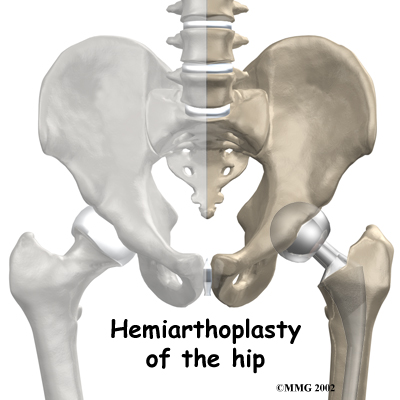
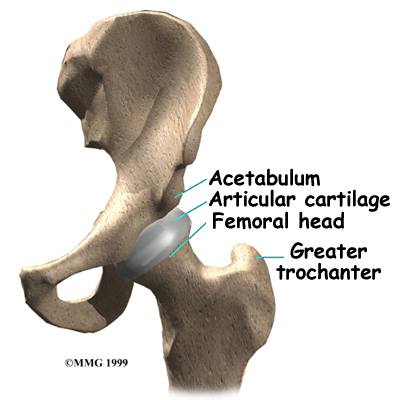 The hip joint is one of the true ball-and-socket joints of the body (the shoulder is the other.) The hip socket is called the acetabulum and forms a deep cup that surrounds the ball of the upper thighbone (femur,) known as the femoral head. The thick muscles of the buttock at the back, and the thick muscles of the thigh in the front surround the hip joint.
The hip joint is one of the true ball-and-socket joints of the body (the shoulder is the other.) The hip socket is called the acetabulum and forms a deep cup that surrounds the ball of the upper thighbone (femur,) known as the femoral head. The thick muscles of the buttock at the back, and the thick muscles of the thigh in the front surround the hip joint.